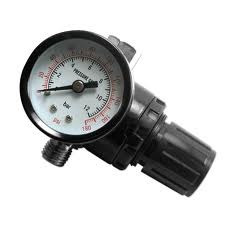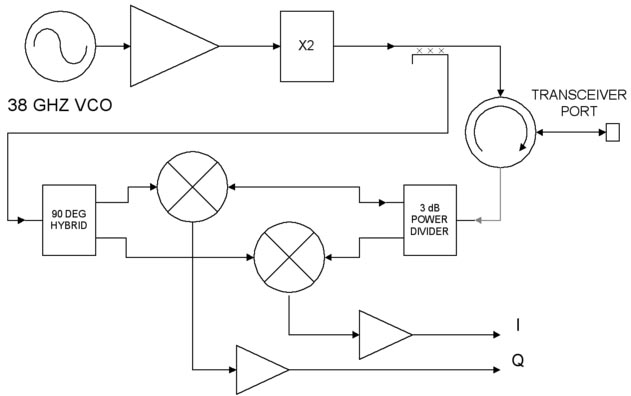Glossary
Then, there is a short list of some words to take into account in the description of the anesthesia machine.
Pressure regulator: Is a control valve that reduce the input of a fluid. In the anesthesia machine, the pressure regulator allow reduce the amount of oxygen or medical air that travel through the system.
 |
| Image 1. Pressure regulator. |
Circuit Diagram: Is a graphic representation of a electric circuit. The circuit diagram show the machine components in a easy way, also show the electrical connections.
Anesthesia: Is the medical act to block the sensitivity of the pacients to reduce the pain at the time of a medical intervention.
The main parts of the anesthesia machine are:
Front View
 |
| Image 2. Example of a circuit diagram. |
Anesthesia: Is the medical act to block the sensitivity of the pacients to reduce the pain at the time of a medical intervention.
| Image 3. Example of anesthesia. |
Vaporizer: Is an accessory that is responsible of maintain the anesthesic vapours in the desired rangeds.
 |
| Image 4. Vaporizer. |
Canister & Soda Lime: Is a cylindrical container that is responsible of contain the soda lime. The canister with soda lime are in charge of purify the breathed air by the patient.
| Image 5. Canister with soda lime. |
The Anesthesia Machine (Julian Anaesthetic Workstation of Drager)
The anesthesia machine is a treatment equip that provide safely gases as oxygen, nitrous oxide, air and anesthetic vapours.
The main parts of the anesthesia machine are:
Front View
- Screen user interface
- Rotary knob to several options
- Main power switch
- Writing top
- Catch to unlock the breathing system
- Bellows
- Canister
- Drawer
- Sucton system
- Breathing Circuit
- Gas supply panel
- Vapors with interlock system
- Mounting rail for accessories
- Shelf for patient monitor
Rear View
- Gas supply ports
- Oxygen and nitrous oxide flowmeters
- Oxigen sensor
- Interface Panel with connections
- Filters to bacterial air and microbaterial particles.
- Waste gas connector
- Hose to anaesthetic gas
- Anaesthetic gas scavenging system
- Power cable
- Cooling air filters
- Connection beetwen water separator and water trap
- Auxilary power sockets
- Earth cable
Other components:
- Two valves corresponding of each flowmeter
- Vaporizer
- Two brackets to oxygen and nitrous oxide tanks
- Two bracets to oxygen and nitrous oxide hoses
- Inhalation and exhalation valves
- Temperature sensor
- Tanks with every gas
- Monitor or display
- Keypad with control of breathing
- Water trap
Operating mode
The flowmeters measure the amount of gas in movement and the valves regule the stream of the gases in the breathing circiut and the anaesthetia machine, so the vaporizers sustain a regulable vaporization inside the limits of concentration deseable..
Pressure gauge measure the tensio fo flows as air or another gases or liquids, measuring the internal preassure in the tanks and the velocity of flow of gas of regulador. The regulator reduce the pressure of gases when its leave the cilinders or its leave gases system. In the canister the exhaled air is purified. The breathing circuit let manage the ventilation and supply of gases with anaesthetic mixture.
Self Test
You must verify that all checklist poins in monitor are OK and with the rotary knob select the selft test, it muet start and testing or calibrate the gas maetering bench, O2 sensor, pressure sensor for airway pressure measurement, flow sensor, battery, and activate the default settings for alarm limits, monitoring parameters and default settings of the ventilator and fresh gas settings of ventilator and freash gas settins. (Pag. 31).
Technical and General Characteristics
This machine detect automatically the current system compliance (depending the breathing hoses used) the current leakage of the breathing system and breathing hoses (tolerating 150mL/min).
When is necessary use the manual ventilation, Julian delivers an O2 flow of 4L/min and it have an option called 'Safety O2' which delivers a range from 0 to 12L/min of lfow of oxigen.
The ventilation mode can be select with the APL pressure liiting valve which can be select MAN (manual ventilation) or SPONT (spontaneous breathing).
The button O2 is used to flushig or filling the breathing system and breathing bag with O2 while bypassing the vapor unit (pag 38).
The another ventilation modes that can be selected are IPPV ventilation (Intermittent positive pressure ventilation), PCV ventilation (pressure controlled ventilation) and ventilation children mode.
Water trap container: It must be pulled down and off and after it must emptied, he can be clean in a washine machine, stelirized and immersed.
The flowmeters measure the amount of gas in movement and the valves regule the stream of the gases in the breathing circiut and the anaesthetia machine, so the vaporizers sustain a regulable vaporization inside the limits of concentration deseable..
Pressure gauge measure the tensio fo flows as air or another gases or liquids, measuring the internal preassure in the tanks and the velocity of flow of gas of regulador. The regulator reduce the pressure of gases when its leave the cilinders or its leave gases system. In the canister the exhaled air is purified. The breathing circuit let manage the ventilation and supply of gases with anaesthetic mixture.
Self Test
You must verify that all checklist poins in monitor are OK and with the rotary knob select the selft test, it muet start and testing or calibrate the gas maetering bench, O2 sensor, pressure sensor for airway pressure measurement, flow sensor, battery, and activate the default settings for alarm limits, monitoring parameters and default settings of the ventilator and fresh gas settings of ventilator and freash gas settins. (Pag. 31).
Technical and General Characteristics
This machine detect automatically the current system compliance (depending the breathing hoses used) the current leakage of the breathing system and breathing hoses (tolerating 150mL/min).
When is necessary use the manual ventilation, Julian delivers an O2 flow of 4L/min and it have an option called 'Safety O2' which delivers a range from 0 to 12L/min of lfow of oxigen.
 |
| Table 1. Adjustment ranges and default sttings on delivery. |
The button O2 is used to flushig or filling the breathing system and breathing bag with O2 while bypassing the vapor unit (pag 38).
 |
Table 2. Characteristics and alarm limits of manualventilation mode. |
 |
| Adjustment ranges and default setting on delivery of IPPV and PCV ventilation mode. |
 |
Adjustment ranges and default setting on delivery
of IPPV and PCV ventilation mode.
|
MAINTENANCE
Breathing hoses: This component muest be dismantled and remove of the circuit and anaesthetic machine and after cleaned of desinfected in a washine machine (take care with don´t damage the breathing hoses while its removing by it connection sleeve and not by the spiral sleeve.
Microbial filters: Press the sleeve to the surface when says 'Press' and pull off the conection (do it without force) adn prepare the filter according to manufacturing instructions.
Suction system: Remove the hoses and pull off the bottle cap of the silicone sleeve, after clean the secretion, flush and empty the bottle. The silicone sleeve and separated parts of collecting bottle have to be cleaned in a washing machine or sterilized.
Bacterian filter: Repalce every two weeks or when is soaked or with suspected of contamination. Is is considered as a infectious special waste, incinerated to 800°C.
SIMULATION
Microbial filters: Press the sleeve to the surface when says 'Press' and pull off the conection (do it without force) adn prepare the filter according to manufacturing instructions.
Suction system: Remove the hoses and pull off the bottle cap of the silicone sleeve, after clean the secretion, flush and empty the bottle. The silicone sleeve and separated parts of collecting bottle have to be cleaned in a washing machine or sterilized.
Bacterian filter: Repalce every two weeks or when is soaked or with suspected of contamination. Is is considered as a infectious special waste, incinerated to 800°C.
SIMULATION
Here you can see a simulation of how this machine work in general way


No hay comentarios:
Publicar un comentario